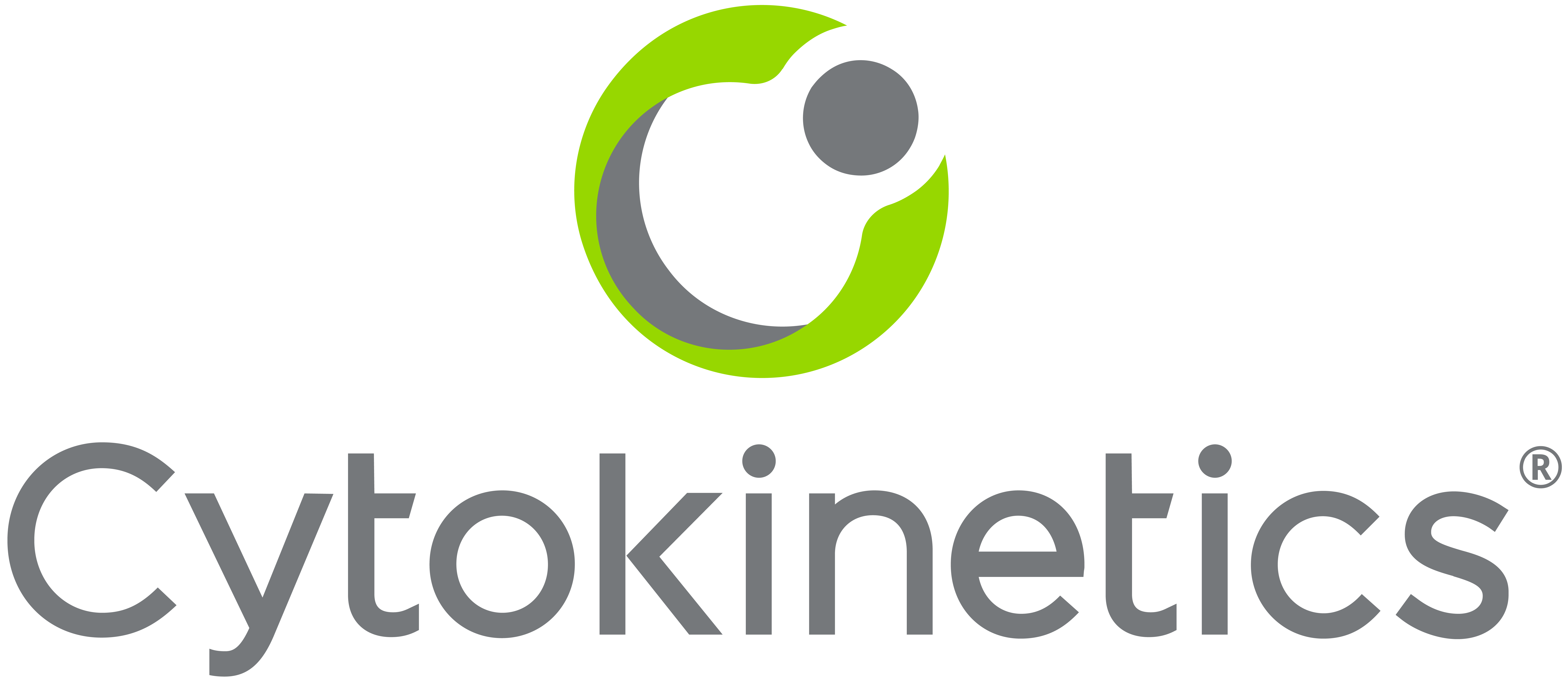Cytokinetics Announces Further Results from BENEFIT-ALS Relating to Effects Following Withdrawal of Tirasemtiv
Effects of Tirasemtiv on Slow Vital Capacity during 12 Weeks of Double-Blind Treatment Were Maintained through 4 Weeks after the Last Dose of Double-Blind Treatment
South San Francisco, CA, June 2, 2014 - Cytokinetics, Incorporated (Nasdaq: CYTK) announced today that additional results from BENEFIT-ALS (Blinded Evaluation of Neuromuscular Effects and Functional Improvement with Tirasemtiv in ALS) were presented yesterday during the Joint Congress of European Neurology at the International Congress Center in Istanbul, Turkey. The new data from BENEFIT-ALS were presented by Jeremy M. Shefner, M.D., Ph.D., Professor and Chair, Department of Neurology at the Upstate Medical University, State University of New York and the Lead Investigator for BENEFIT-ALS.
In BENEFIT-ALS, patients with amyotrophic lateral sclerosis (ALS) were randomized 1:1 to double-blind treatment with tirasemtiv or placebo for 12 weeks. The primary outcome measure, the ALS Functional Rating Scale in its revised form (ALSFRS-R), and secondary outcomes measures of respiratory performance and other measures of skeletal muscle function and fatigability were assessed after 4, 8, and 12 weeks of double-blind treatment, and again at 1 and 4 weeks after the last dose of double-blind treatment. The results from double-blind treatment during BENEFIT-ALS were presented at the Annual Meeting of the American Academy of Neurology. Yesterday, outcome measures obtained at 1 and 4 weeks after the last dose of double-blind study medication were presented and are summarized in the table below.
| Changes from Baseline | ||||
| Outcome Measure | Baseline | After 12 Weeks Double-Blind | 1 Week after Last Double-Blind Dose | 4 Weeks after Last Double-Blind Dose |
| ALSFRS-R | ||||
| Placebo | 37.3 | -2.81 | -2.98 | -3.76 |
| Tirasemtiv | 37.0 | -3.48 | -3.32 | -3.85 |
| p-value | 0.107 | 0.417 | 0.853 | |
| SVC (% predicted) | ||||
| Placebo | 89.7 | -8.66 | -8.03 | -10.30 |
| Tirasemtiv | 85.7 | -3.12 | -3.75 | -5.39 |
| p-value | < 0.0001 | 0.0002 | 0.0002 | |
| SNIP (cm H2O) | ||||
| Placebo | 61.4 | -1.20 | -1.21 | -2.25 |
| Tirasemtiv | 57.8 | -5.03 | -5.28 | -6.21 |
| p-value | 0.050 | 0.039 | 0.064 | |
"We now have evidence that differences in Slow Vital Capacity between tirasemtiv and placebo observed during double-blind treatment in BENEFIT-ALS were maintained up to 4 weeks after discontinuation of treatment," stated Dr. Shefner. "These data suggest that tirasemtiv may have a durable impact on this measure of pulmonary function in patients with ALS which has been shown to predict disease progression in prior clinical trials. These effects, if persistent over longer periods of time, suggest mechanisms by which tirasemtiv could preserve critical functionality in patients with ALS."
Differences detected during double-blind treatment in the percentage changes from baseline in Muscle Strength Mega-Score between tirasemtiv and placebo were not sustained during the follow-up period. No differences in Maximum Voluntary Ventilation and Hand Grip Fatigue were observed on tirasemtiv versus placebo during double-blind treatment nor during the period through 4 weeks after the last double-blind dose.
"These data suggest that tirasemtiv may have effects on the respiratory muscles involved in performing the Slow Vital Capacity assessment that extend beyond its immediate pharmacologic action," stated Andrew A. Wolff, M.D., F.A.C.C., Cytokinetics' Chief Medical Officer and Senior Vice President of Clinical Research and Development. "The absence of a difference between tirasemtiv and placebo on muscle strength and other endpoints at 4 weeks after double-blind treatment is consistent with diminishing pharmacologic effects of tirasemtiv following its discontinuation. We are encouraged by these results and are continuing our analyses of data from BENEFIT-ALS to inform the potential further development of tirasemtiv in patients with ALS."
About Tirasemtiv and BENEFIT-ALS
Tirasemtiv is the lead drug candidate from Cytokinetics' skeletal muscle contractility program. Tirasemtiv selectively activates the fast skeletal muscle troponin complex by increasing its sensitivity to calcium and, in preclinical studies and early clinical trials, demonstrated increases in skeletal muscle force in response to neuronal input and delays in the onset and reductions in the degree of muscle fatigue.
BENEFIT-ALS was a Phase IIb, multi-national, double-blind, randomized, placebo-controlled, clinical trial designed to evaluate the safety, tolerability and efficacy of tirasemtiv in patients with amyotrophic lateral sclerosis (ALS). BENEFIT-ALS enrolled 711 patients in 73 centers in 8 countries. Patients enrolled in BENEFIT-ALS began treatment with open-label tirasemtiv at 125 mg twice daily. 605 patients were randomized 1:1 to receive 12 weeks of double-blind treatment with twice-daily oral ascending doses of tirasemtiv or placebo (302 to placebo; 303 to tirasemtiv), beginning at 125 mg twice daily and increasing weekly up to 250 mg twice daily (or a dummy dose titration with placebo). Clinical assessments occurred every four weeks during double-blind treatment; patients also returned for follow-up evaluations at one and four weeks after their final dose of double-blind study medication. The primary efficacy analysis of BENEFIT-ALS compared the mean change from baseline in the ALS Functional Rating Scale in its revised form (ALSFRS-R) to the average of the scores obtained after 8 and 12 weeks of double-blind treatment on tirasemtiv versus placebo. Secondary endpoints evaluated measures of respiratory performance and other measures of skeletal muscle function and fatigability were assessed after 4, 8, and 12 weeks of double-blind treatment (n = 210, 204, and 199 for placebo and 174, 151 and 144 for tirasemtiv, respectively), and again at 1 and 4 weeks after the last dose of double-blind treatment (n = 191 and 188 for placebo and 156 and 164 for tirasemtiv, respectively).
BENEFIT-ALS did not achieve its primary efficacy endpoint (ALSFRS-R) on tirasemtiv versus placebo (-2.98 points in the tirasemtiv group versus -2.40 points in the placebo group, p = 0.11). However, treatment with tirasemtiv in BENEFIT-ALS resulted in a statistically significant and potentially clinically meaningful reduction in the decline of Percent Predicted Slow Vital Capacity (SVC, a measure of the strength of the skeletal muscles responsible for breathing) that has been shown to be an important predictor of disease progression and survival in prior trials of patients with ALS. After 12 weeks of double-blind treatment, SVC declined by 8.66 percentage points on placebo compared to 3.12 percentage points on tirasemtiv (p < 0.0001).
The Muscle Strength Mega-Score, a measure of strength combining the data from several muscle groups in each patient, declined more slowly on tirasemtiv versus placebo (p = 0.016 for the difference in slope of decline); however, there were no differences at any time point that reached statistical significance. The rate of decline for Sniff Nasal Inspiratory Pressure (SNIP) was not statistically significant different (p = 0.21); however, SNIP decreased more on tirasemtiv compared with placebo in a statistically significant manner at 4 and 12 weeks (p values at 4, 8, and 12 weeks were 0.012, 0.066, 0.050, respectively). No differences in Maximum Voluntary Ventilation and Hand Grip Fatigue were observed on tirasemtiv versus placebo.
About Amyotrophic Lateral Sclerosis (ALS)
Amyotrophic lateral sclerosis is a progressive neurodegenerative disease that afflicts approximately 25,000 people in the United States and a comparable number of patients in Europe. Approximately 5,600 new cases of ALS are diagnosed each year in the United States. The average life expectancy of an ALS patient is approximately three to five years after diagnosis and only 10% of patients survive for more than 10 years. Death is usually due to respiratory failure because of diminished strength in the skeletal muscles responsible for breathing. Few treatment options exist for these patients, resulting in a high unmet need for new therapeutic options to address the symptoms and modify the disease progression of this grievous illness.
About Cytokinetics
Cytokinetics is a clinical-stage biopharmaceutical company focused on the discovery and development of novel small molecule therapeutics that modulate muscle function for the potential treatment of serious diseases and medical conditions. Cytokinetics' lead drug candidate from its cardiac muscle contractility program, omecamtiv mecarbil, is in Phase II clinical development for the potential treatment of heart failure. Amgen Inc. holds an exclusive license worldwide to develop and commercialize omecamtiv mecarbil and related compounds, subject to Cytokinetics' specified development and commercialization participation rights. Cytokinetics is independently developing tirasemtiv, a fast skeletal muscle activator, as a potential treatment for diseases and medical conditions associated with neuromuscular dysfunction. Tirasemtiv is the subject of a Phase II clinical trials program and has been granted orphan drug designation and fast track status by the U.S. Food and Drug Administration and orphan medicinal product designation by the European Medicines Agency for the potential treatment of amyotrophic lateral sclerosis (ALS). Cytokinetics is collaborating with Astellas Pharma Inc. to develop CK-2127107, a skeletal muscle activator structurally distinct from tirasemtiv, for non-neuromuscular indications. All of these drug candidates have arisen from Cytokinetics' muscle biology focused research activities and are directed towards the cytoskeleton. The cytoskeleton is a complex biological infrastructure that plays a fundamental role within every human cell. Additional information about Cytokinetics can be obtained at www.cytokinetics.com.
Forward-Looking Statements
This press release contains forward-looking statements for purposes of the Private Securities Litigation Reform Act of 1995 (the "Act"). Cytokinetics disclaims any intent or obligation to update these forward-looking statements, and claims the protection of the Act's Safe Harbor for forward-looking statements. Examples of such statements include, but are not limited to, statements relating to Cytokinetics' research and development activities, including the potential significance and utility of the results from BENEFIT-ALS and other studies of tirasemtiv; planned further analyses of the results from BENEFIT-ALS and the potential outcomes of such analyses; potential further development of tirasemtiv; the potential size of markets for tirasemtiv; and the properties and potential benefits of tirasemtiv and Cytokinetics' other drug candidates. Such statements are based on management's current expectations, but actual results may differ materially due to various risks and uncertainties, including, but not limited to, the results of BENEFIT-ALS may not support further clinical development of tirasemtiv; further clinical development of tirasemtiv in ALS patients, if supported by the BENEFIT-ALS data, will require significant additional funding, and Cytokinetics may be unable to obtain such additional funding on acceptable terms, if at all; potential difficulties or delays in the development, testing, regulatory approvals for trial commencement, progression or product sale or manufacturing, or production of Cytokinetics' drug candidates that could slow or prevent clinical development or product approval, including risks that current and past results of clinical trials or preclinical studies may not be indicative of future clinical trials results, patient enrollment for or conduct of clinical trials may be difficult or delayed, Cytokinetics' drug candidates may have adverse side effects or inadequate therapeutic efficacy, the U.S. Food and Drug Administration or foreign regulatory agencies may delay or limit Cytokinetics' or its partners' ability to conduct clinical trials, and Cytokinetics may be unable to obtain or maintain patent or trade secret protection for its intellectual property; Amgen's and Astellas' decisions with respect to the design, initiation, conduct, timing and continuation of development activities for omecamtiv mecarbil and CK-2127107, respectively; Cytokinetics may incur unanticipated research and development and other costs or be unable to obtain additional financing necessary to conduct development of its products; Cytokinetics may be unable to enter into future collaboration agreements for its drug candidates and programs on acceptable terms, if at all; standards of care may change, rendering Cytokinetics' drug candidates obsolete; competitive products or alternative therapies may be developed by others for the treatment of indications Cytokinetics' drug candidates and potential drug candidates may target; and risks and uncertainties relating to the timing and receipt of payments from its partners, including milestones and royalties on future potential product sales under Cytokinetics' collaboration agreements with such partners. For further information regarding these and other risks related to Cytokinetics' business, investors should consult Cytokinetics' filings with the Securities and Exchange Commission.
Contact:
Joanna L. Goldstein
Manager, Investor Relations & Corporate Communications
(650) 624-3060



